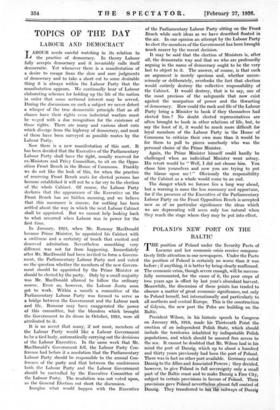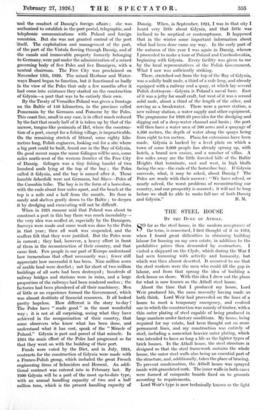POLAND'S NEW PORT ON THE BALTIC
THE position of Poland under the Security Pacts of Locarno and her economic crisis receive compara- tively little attention in our newspapers. Under the Pacts the position of Poland is certainly no worse than it was. before ; if anything, it is better by being clearly reaffirmed. The economic crisis,'though severe enough, will be success- fully surmounted, for the cause of it, the poor crops of two years ago is offset by last year's abundant harvest. Meanwhile, the discussion of these points has tended to obscure a matter of great economic significance, not only to Poland herself, but internationally and particularly to all northern and central Europe. This is the construction of Gdynia, the new port the Poles are building on the Baltic.
President Wilson, in his historic speech to Congress on January 6th, 1918, made his Thirteenth Point the . erection of an independent Polish State. which should include the territories inhabited by indisputable Polish populations, and which should be assured free access to the sea. It cannot be doubted that Mr. Wilson had in his mind the port of Danzig, which up to about a hundred and thirty years previously had been the port of Poland. There was in fact no other port available. Germany ceded Danzig to the Allies and Associated Powers ; they decided, however, to give Poland in full sovereignty only a small part of the Baltic coast and to make Danzig a Free City, subject to certain provisions in favour of Poland. Theie provisions.gave Poland nevertheless almost full control of Danzig. They transferred to her railways of Danzig ''and the conduct of Danzig's foreign affairs ; she was.
'authorized to establish in the -port postal, telegraphic, and telephonic communications with Poland and foreign countries. But she was not granted control of the port 'itself. The exploitation and management of the port, of the part of the Vistula flowing through Danzig, and of the canals and immovable property formerly belonging .to Germany, were put under the administration of a mixed .
.governing body of five Poles and five Danzigers, with a neutral chairman. The Free City was proclaimed on November 15th, 1920. The mixed Harbour and Water- ways Board- began to function, but it functioned so badly in the view of the Poles that only a few months after it had come into existence they started on the construction of Gdynia—a port that was to be entirely their own.
By the Treaty of Versailles Poland was given a frontage on the Baltic of 146 kilometres, in the province called Pomerania by the Germans and Pomerze by the Poles.
This coast line, small in any case, is in effect much reduced by the fact that nearly half of it is taken up by that of the narrow, tongue-like peninsula of Hel, where the construc- tion of a port, except for a fishing village, is impracticable. On the remaining stretch of littoral, some eighty kilo- metres long, Polish engineers, looking out for a site where a big port could be built, found one in the Bay of Gdynia. On good recent maps the name Gdingen will be seen, some miles north-west of the western frontier of the Free City of Danzig. Gdingen was a tiny fishing hamlet of two hundred souls lying at the top of the bay ; the Poles called it Gdynia, and the bay is named after it. These humble fisherfolk were not Germans, but Slays—Poles of the Cassubia tribe. The bay is- in the form of a horseshoe, with the ends about four miles apart, and the beach at the top is a mile and a half from the mouth. Its floor is sandy and shelves gently down to the Baltic ; to deepen it by dredging and excavating will not be difficult.
. When in 1921 rumour said that Poland was about to construct a port in this bay there was much incredulity— the very idea was scoffed at, especially by the Danzigers.
Surveys were made and some work was done by the Poles in that year; then all work was suspended, and the scoffers felt that they were justified. But the Poles were in earnest ; they had, however, a heavy effort in front of them in the reconstruction of their country, and that came first. Few people in our part of Europe understand how tremendous that effort necessarily was ; fewer still appreciate how successful it has been. Nine million acres of arable land were derelict ; not far short of two million buildings of all sorts had been destroyed ; hundreds of railway bridges and stations were in ruins, and a large proportion of the railways had been rendered useless ; the factories had been plundered of all their machinery. Men of little or no experience formed the Government, which was almost destitute of financial resources. It all looked pretty hopeless. How different is the story to-day ! The Poles have " made good " in the most wonderful way ; it is not at all surprising, seeing what they have achieved in the reorganization of their country, that some observers who know what has been done, and understand what it has cost, speak of the " Miracle of Poland." Gdynia is part and parcel of that miracle. In 1924 the main effort of the Poles had progressed so far that they went on with the building of their port.
Funds were voted by the Diet, and in July, 1924, contracts for the construction of Gdynia were made with a Franco-Polish group, which included the great French engineering firms of Schneiders and Hersent. An addi- tional contract was entered into in February last. By 1930 Gdynia will be a port of the most up-to-date type, with an annual handling capacity of two and a half million tons, which is the present handling capacity of Danzig. When, in September, 1924, I was in that city I heard very little about Gdynia, and that little was inclined to be sceptical or contemptuous. It happened that in the winter some important information about what had been done came my way. In the early part of the autumn of this year I was again in Danzig, whence. I proceeded to make a tour of Poland and Czechoslovakia, beginning with Gdynia. Every facility was given to me by the local representatives of the Polish Government. What I saw was sufficiently striking.
There, stretched out from the top of the Bay of Gdynia, was a solidly built mole, a third of a mile long, and already equipped with a railway and a quay, at which lay several Polish destroyers—Gdynia is Poland's naval base. East of it was a jetty for small craft, but west of it was a second solid mole, about a third of the length of the other, and serving as a breakwater. There were a power station, a new railway station, a water supply and other equipment. The programme for 1926-29 provides for the dredging and digging out of a deep-water channel and basin ; the port will then have a water area of 500 acres and a quayage of 4,500 metres, the depth of water along the quays being from eight to ten metres. Plans for extensions have been made. Gdynia is backed by a level plain on which a town of some 3,000 people has already sprung up, with hotels, a brand new casino, and a number of villas. A few miles away are the little forested hills of the Baltic Heights that terminate, east and west, in high bluffs facing the sea—the ends of the horseshoe bay. If Gdynia succeeds, what, it may be asked, about Danzig ? The Poles are ready with their answer : " We have solved, or nearly solved, the worst problems of reconstructing our country, and our prosperity is assured ; it will not be long before we shall be able to make full use of both Danzig























































 Previous page
Previous page